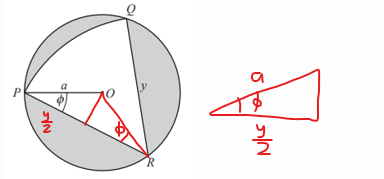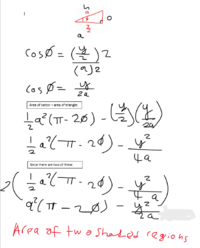You are using an out of date browser. It may not display this or other websites correctly.
You should upgrade or use an alternative browser.
You should upgrade or use an alternative browser.
Is my answer wrong? I got (1/2)a^2(2π−sin(2Ø)−2cos(Ø))
- Thread starter Kulla_9289
- Start date
Kulla_9289
Junior Member
- Joined
- Apr 18, 2022
- Messages
- 237
It's 1/8.
blamocur
Elite Member
- Joined
- Oct 30, 2021
- Messages
- 3,224
Take a closer look at the post # 19 by @Dr.PetersonHow do I remove the y, as the question only wants it in terms of a and ϕ?
Kulla_9289
Junior Member
- Joined
- Apr 18, 2022
- Messages
- 237
I did. I got y in my new answer.
Dr.Peterson
Elite Member
- Joined
- Nov 12, 2017
- Messages
- 16,873
I have thought about it and used a circle theorem to get to [imath](a)^2(π-2ϕ)+\frac{1}{2}(a^2)(4ϕ)-\frac{1}{2}(y^2)(ϕ)[/imath].
Edit: I have simplified it to [imath]πa^2-\frac{1}{2}y^2ϕ[/imath]. How do I remove the y, as the question only wants it in terms of a and ϕ?
I did. I got y in my new answer.
But you don't want y in the answer.
You've already been told that you can express y in terms of a and phi; and I showed you a picture to help with that. Do that, substitute for y, and you will not have y in the answer; everything will be in terms of a and phi. Do you see this?
Kulla_9289
Junior Member
- Joined
- Apr 18, 2022
- Messages
- 237
[imath]y=\sqrt{\frac{a^2π}{Φ}}[/imath]. And finally, got it to [imath]πa^2-\frac{1}{2}(a^2π)[/imath]. No one deserves to lose a point here because of this.
Last edited:
blamocur
Elite Member
- Joined
- Oct 30, 2021
- Messages
- 3,224
How did you get your expression for [imath]y[/imath] ?[imath]y=\sqrt{\frac{a^2π}{Φ}}[/imath]. And finally, got it to [imath]πa^2-\frac{1}{2}(a^2π)[/imath]. No one deserves to lose a point here because of this.
Kulla_9289
Junior Member
- Joined
- Apr 18, 2022
- Messages
- 237
I made it into an equation equated to 0; then brought half y^2 to the other side.
Dr.Peterson
Elite Member
- Joined
- Nov 12, 2017
- Messages
- 16,873
Please show the details of your work, so we can see where you are thinking incorrectly. What was that equation, and why did you think it was valid?I made it into an equation equated to 0; then brought half y^2 to the other side.
Kulla_9289
Junior Member
- Joined
- Apr 18, 2022
- Messages
- 237
This is my final answer: a²π-y²∅. I do not know how one would remove the y. Ignore the other answers I said earlier.
Otis
Elite Member
- Joined
- Apr 22, 2015
- Messages
- 4,589
1/2*4 = 2
It's 1/8.
1/2*4 = 2
1/(2*4) = 1/8
Order of Operations
[imath]\;[/imath]
Steven G
Elite Member
- Joined
- Dec 30, 2014
- Messages
- 14,603
Was that you in my remedial arithmetic class last semester?1/2*4 = 2
1/(2*4) = 1/8
Order of Operations
[imath]\;[/imath]
blamocur
Elite Member
- Joined
- Oct 30, 2021
- Messages
- 3,224
Are you having difficulty with the triangle in the post #19? Have you tried to work it out? What have you tried to find [imath]y[/imath] ?This is my final answer: a²π-y²∅. I do not know how one would remove the y. Ignore the other answers I said earlier.
Dr.Peterson
Elite Member
- Joined
- Nov 12, 2017
- Messages
- 16,873
This is my final answer: a²π-y²∅. I do not know how one would remove the y. Ignore the other answers I said earlier.

Solve for [imath]y[/imath] in terms of [imath]a[/imath] and [imath]\phi[/imath]. Then put the resulting expression into [imath]a^2\pi-(...)^2\phi[/imath].
But also, check whether what you want in your second term is really [imath]\phi[/imath].
Kulla_9289
Junior Member
- Joined
- Apr 18, 2022
- Messages
- 237
My approach:
1) [imath]πr^2-\frac{1}{2}r^2θ[/imath]
2) [imath]πa^2-\frac{1}{2}y^2ϕ[/imath]
I have also used your triangle approach to get the same answer. There will be 4 of these triangles you have sketched out. The area of all 4 triangles gets cancelled out later on.
1) [imath]πr^2-\frac{1}{2}r^2θ[/imath]
2) [imath]πa^2-\frac{1}{2}y^2ϕ[/imath]
I have also used your triangle approach to get the same answer. There will be 4 of these triangles you have sketched out. The area of all 4 triangles gets cancelled out later on.
Kulla_9289
Junior Member
- Joined
- Apr 18, 2022
- Messages
- 237
Dr.Peterson
Elite Member
- Joined
- Nov 12, 2017
- Messages
- 16,873
You are misunderstanding what "my approach" is.Here is the area of two shaded regions using your approach:
I am not (primarily) saying that your formula with y is wrong, or should be obtained a different way; I am telling you to solve that little right triangle for the value of y, given known values of a and [imath]\phi[/imath]. I don't think you've even tried doing that yet, except perhaps when you said this:
That formula for y is wrong; but you never showed us the steps you took to get it, so we could help you correct it.[imath]y=\sqrt{\frac{a^2π}{Φ}}[/imath]. And finally, got it to [imath]πa^2-\frac{1}{2}(a^2π)[/imath].
Kulla_9289
Junior Member
- Joined
- Apr 18, 2022
- Messages
- 237
Is the value of y = 2a cosϕ?
Dr.Peterson
Elite Member
- Joined
- Nov 12, 2017
- Messages
- 16,873
Yes. Now finish!Is the value of y = 2a cosϕ?

